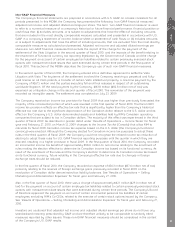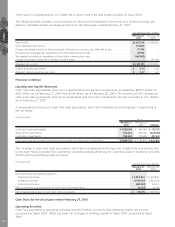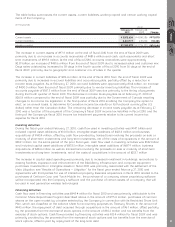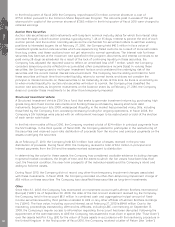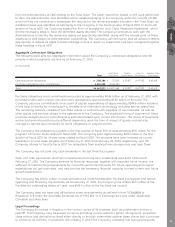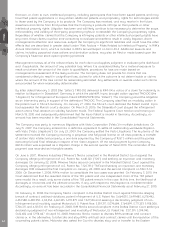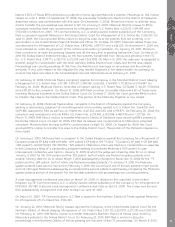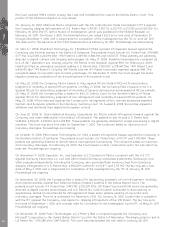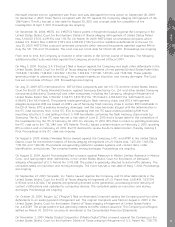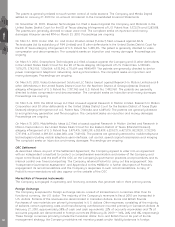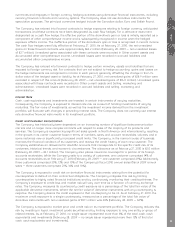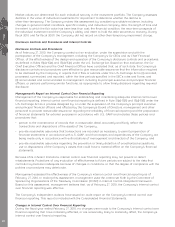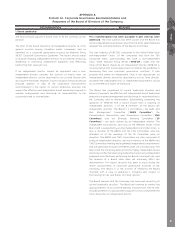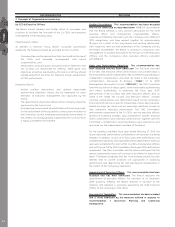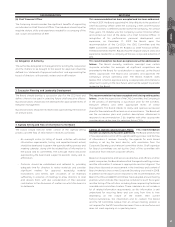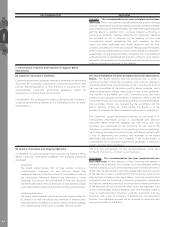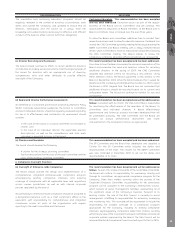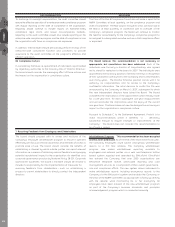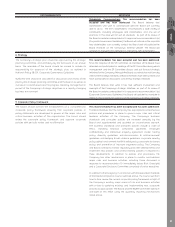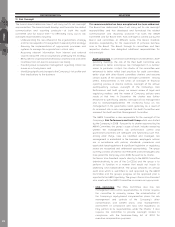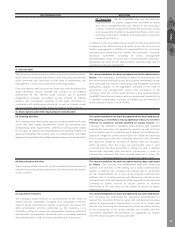Blackberry 2010 Annual Report Download - page 47
Download and view the complete annual report
Please find page 47 of the 2010 Blackberry annual report below. You can navigate through the pages in the report by either clicking on the pages listed below, or by using the keyword search tool below to find specific information within the annual report.
currencies and engages in foreign currency hedging activities using derivative financial instruments, including
currency forward contracts and currency options. The Company does not use derivative instruments for
speculative purposes. The principal currencies hedged include the Canadian dollar, Euro and British Pound.
The Company has entered into forward contracts to hedge exposures relating to foreign currency anticipated
transactions and these contracts have been designated as cash flow hedges. For a derivative instrument
designated as a cash flow hedge, the effective portion of the derivative’s gain or loss is initially reported as a
component of other comprehensive income and is subsequently recognized in income when the hedged
exposure affects income. The ineffective portion of the derivative’s gain or loss is recognized in current income.
The cash flow hedges were fully effective at February 27, 2010. As at February 27, 2010, the net unrealized
gains on these forward contracts was approximately $62.2 million (February 28, 2009 — net unrealized losses
of $2.7 million). Unrealized gains associated with these contracts were recorded in Other current assets and
Accumulated other comprehensive income. Unrealized losses were recorded in accrued liabilities and
accumulated other comprehensive income.
The Company has entered into forward contracts to hedge certain monetary assets and liabilities that are
exposed to foreign currency risk. For contracts that are not subject to hedge accounting, gains and losses on
the hedge instruments are recognized in income in each period, generally offsetting the change in the U.S.
dollar value of the hedged asset or liability. As at February 27, 2010, net unrealized gains of $28.9 million were
recorded in respect of this amount (February 28, 2009 — net unrealized gains of $16.0 million). Unrealized gains
associated with these contracts were recorded in Other current assets and Selling, marketing and
administration. Unrealized losses were recorded in accrued liabilities and selling, marketing and
administration.
Interest Rate
Cash, cash equivalents and investments are invested in certain instruments of varying maturities.
Consequently, the Company is exposed to interest rate risk as a result of holding investments of varying
maturities. The fair value of investments, as well as the investment income derived from the investment
portfolio, will fluctuate with changes in prevailing interest rates. The Company does not currently use interest
rate derivative financial instruments in its investment portfolio.
Credit and Customer Concentration
The Company has historically been dependent on an increasing number of significant telecommunication
carriers and on larger more complex contracts with respect to sales of the majority of its products and
services. The Company is experiencing significant sales growth in North America and internationally, resulting
in the growth in its carrier customer base in terms of numbers, sales and account receivables volumes and in
some instances new or significantly increased credit limits. The Company, in the normal course of business,
monitors the financial condition of its customers and reviews the credit history of each new customer. The
Company establishes an allowance for doubtful accounts that corresponds to the specific credit risk of its
customers, historical trends, and economic circumstances. The allowance as at February 27, 2010 is $2.0 million
(February 28, 2009 — $2.1 million). The Company also places insurance coverage for a portion of its foreign
accounts receivables. While the Company sells to a variety of customers, one customer comprised 14% of
accounts receivables as at February 27, 2010 (February 28, 2009 — one customer comprised 29%). Additionally,
three customers comprised 20%, 13% and 10% of the Company’s fiscal 2010 annual sales (fiscal 2009 annual
sales — three customers comprised 23%, 14% and 10%).
The Company is exposed to credit risk on derivative financial instruments arising from the potential for
counterparties to default on their contractual obligations. The Company mitigates this risk by limiting
counterparties to highly rated financial institutions and by continuously monitoring their creditworthiness. The
Company’s exposure to credit loss and market risk will vary over time as a function of currency exchange
rates. The Company measures its counterparty credit exposure as a percentage of the total fair value of the
applicable derivative instruments. Where the net fair value of derivative instruments with any counterparty is
negative, the Company deems the credit exposure to that counterparty to be nil. As at February 27, 2010, the
maximum credit exposure to a single counterparty, measured as a percentage of the total fair value of
derivative instruments with net unrealized gains of $91.1 million was 24% (February 28, 2009 — 60%).
The Company is exposed to market price and credit risk on its investment portfolio. The Company reduces this
risk by investing in liquid, investment grade securities and by limiting exposure to any one entity or group of
related entities. As at February 27, 2010, no single issuer represented more than 8% of the total cash, cash
equivalents and investments (February 28, 2009 — no single issuer represented more than 12% of the total
cash, cash equivalents and investments).
MD&A
39


